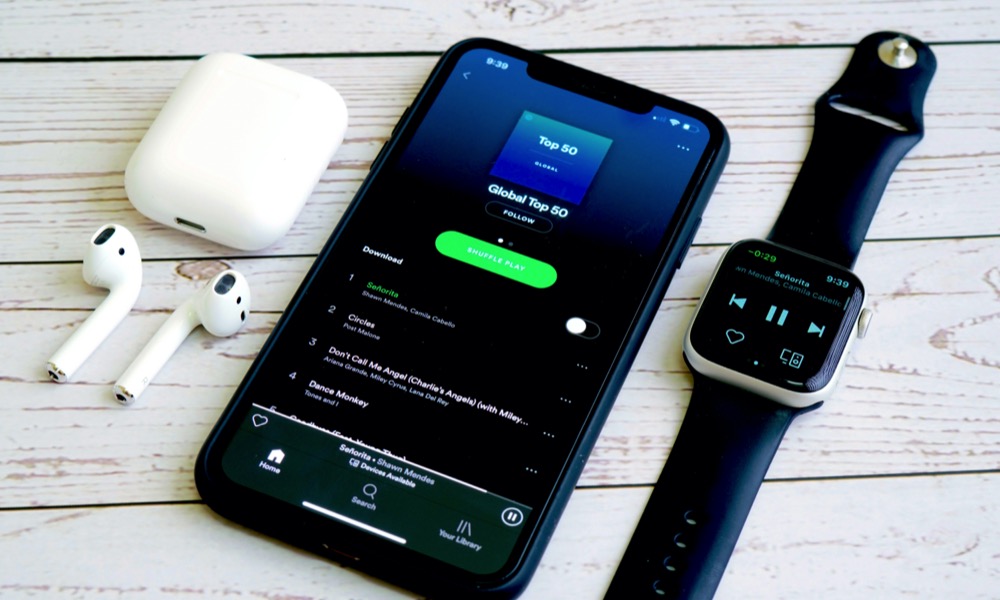Even in the Midst of a Pandemic, Apple’s Wearables Continue to Dominate
 Credit: Moma Okgo / Shutterstock
Credit: Moma Okgo / Shutterstock
Toggle Dark Mode
As much as Apple admitted that it’s expecting sales of its wearable devices to slow down this year in the midst of the global health crisis, there’s been no indication so far that this is happening, and in fact thanks to AirPods and Beats, the company actually has no rival in the wearables market.
During its Q1 2020 earnings call last month, Apple announced that it shattered its previous quarterly sales record in its Wearables, Home, and Accessories category, which includes everything from the AirPods and Beats headphones and the Apple Watch to the HomePod, Apple TV, and Apple’s keyboards, cases, adapters and cables.
While Apple doesn’t break down the product sales within this broader category, it doesn’t take a lot of insight to figure out that it’s the “wearables” portion of that category that accounted for the lion’s share of Apple’s revenue increase, since the AirPods remain insanely popular, and Apple’s Beats headphones brand and Apple Watch are still far better performers than devices like the HomePod, Apple TV, or even Apple’s new Magic Keyboard for the iPad Pro (which was released too late to factor into the Q1 sales figures anyway).
However, a new report by technology market analyst IDC sheds some light on just how significant the growth within Apple’s wearables segment actually was, with a look at how Apple’s products fared against its fiercest competitors.
AirPods Carried the Day
In total, IDC estimates that Apple shipped 21.2 million units of wearable products in the first quarter of 2020, which works out to about 29.3% of the total marketshare.
It probably won’t come as a huge surprise that it was Apple’s AirPods that are estimated as being the most responsible for Apple’s growth in this segment. When Apple released its original AirPods back in 2016, they weren’t just a flash in the pan; demand for those first-gen earbuds continued dominating the market two years later, even with rumours of the impending release of the second-generation version.
Still, IDC doesn’t try to break down individual product sales, beyond noting that it was “the strength of the Beats and Airpods [sic] lineup” the ultimately offset negative growth in other areas.
The Negative Growth
So where was the negative growth that AirPods and Beats needed to offset? According to IDC, the Apple Watch saw a decline in shipments, although it didn’t blame this on a lack of demand — the Apple Watch still has no rival — but rather due to supply chain problems as a result of the novel coronavirus pandemic.
The spread of COVID-19 also had adverse effects on the supply of smart and basic watches as many of these devices share components and resources with smartphones and PCs.
IDC
While some smartwatch makers such as Huawei, Garmin, and Huami seemed to still see growth in this category, “thanks to lesser reliance on markets in China,” most wearable wristband devices were negatively impacted by the health crisis.
‘Hearables’ Remain in Demand
One of the interesting points that IDC notes is that “hearables” which as the name implies is the sub-category of wearables that defines headphones, earphones, and earbuds, is actually not being impacted by “the market-suppressing forces caused by COVID-19.”
It seems that consumers who are otherwise stuck at home during the pandemic are “clamouring” for these devices to not only listen to audio, but to increase productivity in order to help them filter out background noise and stay focused while working from home — something that we can tell you from personal experience that the AirPods Pro are absolutely great for, thanks to their active noise cancellation.
By the Numbers
So while Apple came out on top with 21.2 million unit shipments, how did the rest fare?
The other contenders named in the IDC report were Xiamoi, Samsung, Huawei, and Fitbit, in that order, and Xiaomi was actually in a pretty distance second place, with only 10.1 million shipments of its various devices. Meanwhile, Samsung and Huawei each accounted for about 8–9 million shipments, while Fitbit trailed behind at 2.2 million.
That said, there was a fairly healthy “other” category that was comprised of 22.3 million shipments, suggesting that there are a lot of smaller players out there who are shipping much smaller numbers of products.
Apple’s shipments also gave it a 29.3% market share overall, and a 59.9% year-over-year growth, and while we’d attribute most of that to the new second-generation AIrPods and AirPods Pro, which didn’t exist in Q1 2019, it’s interesting that Apple wasn’t the clear leader in growth, with Xiamoi coming in at a close second at 56.4%, while Samsung and Huawei both beat out Apple for growth in their respective categories, at 71.7% and 62.2%, respectively. Fitbit, on the other hand, actually saw its growth shrink, but that may not be surprising since it makes only fitness wristbands — a category that IDC already noted shrunk across the board with even Apple seeing a 2.2% year-over-year decline in shipments.
Still, Apple has been trying to manage expectations among investors in the midst of an uncertain market. During last month’s quarterly earnings call, Apple predicted that both wearables and iPhone sales are expected to slow next quarter as customers shift their spending to devices such as iPads and Macs that are more typically needed to work and learn from home, however based on the analysis from IDC, it looks like many people are including AirPods and Beats headphones in that category as well.







